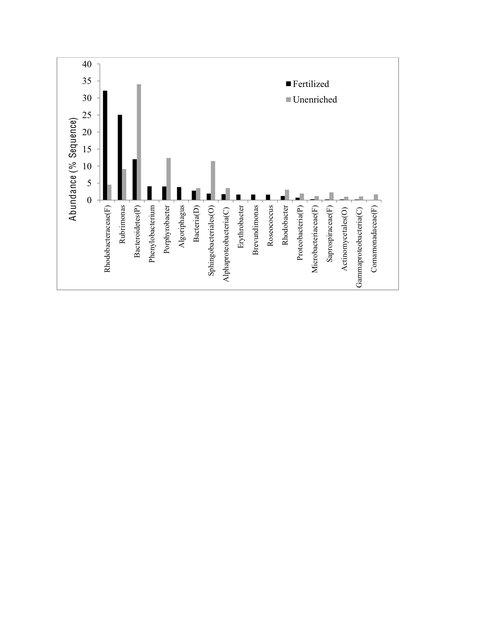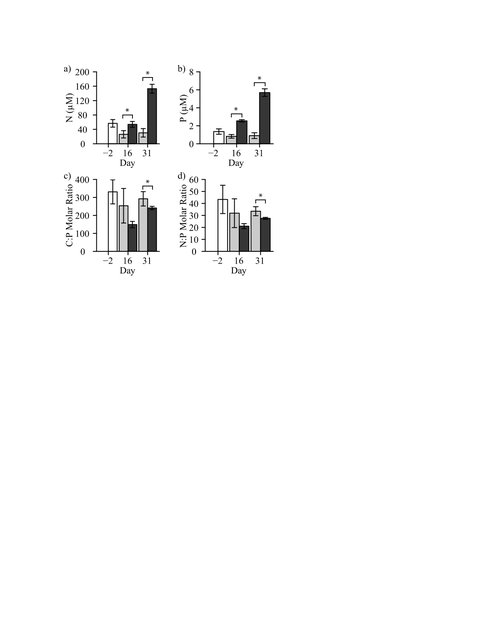2013 Annual Science Report
 Arizona State University
Reporting | SEP 2012 – AUG 2013
Arizona State University
Reporting | SEP 2012 – AUG 2013
Stoichiometry of Life, Task 2b: Field Studies - Cuatro Cienegas
Project Summary
Cuatro Cienegas is a unique biological preserve in México (state of Coahuila) in which there is striking microbial diversity, potentially related to extreme scarcity of phosphorus. We aim to understand this relationship via field sampling of biological and chemical characteristics and a series of enclosure and whole-pond fertilization experiments. We performed two studies to evaluate ecological impacts of nitrogen and/or phosphorus fertilization in a P-deficient and hyperdiverse shallow pond in the valley of Cuatro Cienegas, Mexico.
Project Progress
Phosphorus limitation and element use in microbial communities: A manuscript reporting biogeochemical responses in our 2011 mesocosm experiment in the small evaporative pond Lagunita has been submitted to Limnology and Oceanography for review. Deep pyro sequencing of 16S and 18S rDNA extracted from water and sediment was performed on all replicates and conditions during this short-term fertilization experiment as well as for a survey of 11 sediment and soil sites within the Churince drainage. We are currently analyzing these molecular data in preparation of a new manuscript. Overall, we saw a strong response of the aquatic microbial community to all fertilized treatments. Prior to enrichment, Lagunita was dominated by taxa from the Bacteroidetes but became dominated by uncharacterized Rhodobacteraceae and Rubrimonas in response to the fertilizer application (Refer to Figure 1). More importantly, taxa that are not well characterized and have few cultivated representatives, such as Sphingobacteriales, Comamonadaceae, and Saprospiraceae, were found to decrease in relative abundance in the fertilized treatments. On the other hand, well-characterized genera such as Rubrimonas, Erythrobacter and Roseococcus increased in the fertilized mesocosms. A preview of these data will be presented at the ASLO February 2014 meeting.
In 2012, we conducted a whole-pond fertilization experiment of Lagunita, combined with five internal unenriched controls. The biogeochemical data are currently being analyzed. With a longer fertilization period for this experiment, we were able to observe an initial phase of slow immobilization of nutrients into the seston in the first 16 days. This was followed by rapid uptake in the later 16 days of the experiment (Refer to Figure 2a and b). In contrast to the mesocosm experiment, fertilizer application had a minimal effect on seston C:N:P ratios (Refer to Figure 2c and d). Seston C:N:P ratios decreased somewhat when compared to the controls on day 16 but increased to values comparable to the controls by the end of the experiment. In addition to biogeochemical responses, we have also submitted genomic DNA for shotgun metagenomic sequencing of 24 samples collected as part of the whole-pond fertilization experiment and its five replicated internal control mesocosms. This will allow us to determine changes in the microbial community composition as well as shifts in associated metabolic pathways. Bio-informatic analyses of 16S results are ongoing, while 18S and shotgun metagenomic analyses will commence in the next year.
Calcification, nutrient cycling, and microbial community structure in Río Mesquites stromatolites:
Jessica Corman, PhD candidate finished her dissertation fieldwork in Cuatro Ciénegas with a final study of nutrient limitation to microbial communities in Río Mesquites. Unlike the microbial communities growing in oncoid stromatolites, non-lithifying microbial communities do not show phosphorus limitation. In combination with her earlier work, this result suggests that nutrient constraints may be important to the formation of lithifying microbial structures.
Diverse aquatic environments of Cuatro Ciénegas:
During the summer of 2013, graduate students Jessica Corman and Jorge Ramos completed their three-year sampling effort of over 30 distinct water bodies in the valley. They are continuing the biogeochemical analysis of these water and sediment samples and beginning to analyze the results. Jessica Corman also continued monitoring the environmental succession in the Poza Rojas, a series of ephemeral saline pools that formed after flooding in 2010.
Environmental microbiology. Valeria Souza, UNAM researcher continued to advance studies in association with the NASA NAI project to describe the microbial community structure and genetic composition of various ecosystems at Cuatro Ciénegas, including soil and sediment microbes as well as the microbes composing various stromatolite structures in the basin. In the Churince System, microbial community structure is related to local physicochemical characteristics and nutrient availability, suggesting the environment determines microbial community composition.
Publications
-
Bonilla-Rosso, G., Eguiarte, L. E., Romero, D., Travisano, M., & Souza, V. (2012). Understanding microbial community diversity metrics derived from metagenomes: performance evaluation using simulated data sets. FEMS Microbiology Ecology, 82(1), 37–49. doi:10.1111/j.1574-6941.2012.01405.x
-
Delgado, G., Souza, V., Morales, R., Cerritos, R., González-González, A., Méndez, J. L., … Cravioto, A. (2013). Genetic Characterization of Atypical Citrobacter freundii. PLoS ONE, 8(9), e74120. doi:10.1371/journal.pone.0074120
-
González-González, A., Sánchez-Reyes, L. L., Delgado Sapien, G., Eguiarte, L. E., & Souza, V. (2013). Hierarchical clustering of genetic diversity associated to different levels of mutation and recombination in Escherichia coli: A study based on Mexican isolates. Infection, Genetics and Evolution, 13, 187–197. doi:10.1016/j.meegid.2012.09.003
-
López-Lozano, N. E., Heidelberg, K. B., Nelson, W. C., García-Oliva, F., Eguiarte, L. E., & Souza, V. (2013). Microbial secondary succession in soil microcosms of a desert oasis in the Cuatro Cienegas Basin, Mexico. PeerJ, 1, e47. doi:10.7717/peerj.47
-
Pajares, S., Bonilla-Rosso, G., Travisano, M., Eguiarte, L. E., & Souza, V. (2012). Mesocosms of Aquatic Bacterial Communities from the Cuatro Cienegas Basin (Mexico): A Tool to Test Bacterial Community Response to Environmental Stress. Microbial Ecology, 64(2), 346–358. doi:10.1007/s00248-012-0045-7
-
Pajares, S., Eguiarte, L. E., Bonilla-Rosso, G., & Souza, V. (2013). Drastic changes in aquatic bacterial populations from the Cuatro Cienegas Basin (Mexico) in response to long-term environmental stress. Antonie van Leeuwenhoek, 104(6), 1159–1175. doi:10.1007/s10482-013-0038-7
-
Pérez-Gutiérrez, R-A., López-Ramírez, V., Islas, Á., Alcaraz, L. D., Hernández-González, I., Olivera, B. C. L., … Olmedo-Alvarez, G. (2012). Antagonism influences assembly of a Bacillus guild in a local community and is depicted as a food-chain network. ISME J, 7(3), 487–497. doi:10.1038/ismej.2012.119
-
Rodríguez-Verdugo, A., Souza, V., Eguiarte, L. E., & Escalante, A. E. (2012). Diversity across Seasons of CulturablePseudomonasfrom a Desiccation Lagoon in Cuatro Cienegas, Mexico. International Journal of Microbiology, 2012, 1–10. doi:10.1155/2012/201389
-
PROJECT INVESTIGATORS:
-
PROJECT MEMBERS:
Ariel Anbar
Co-Investigator
Jessica Corman
Collaborator
Christopher Dupont
Collaborator
Zarraz Lee
Collaborator
Amisha Poret-Peterson
Collaborator
Jorge Ramos
Collaborator
Janet Siefert
Collaborator
Valeria Souza
Collaborator
-
RELATED OBJECTIVES:
Objective 5.1
Environment-dependent, molecular evolution in microorganisms
Objective 5.2
Co-evolution of microbial communities
Objective 5.3
Biochemical adaptation to extreme environments
Objective 6.1
Effects of environmental changes on microbial ecosystems
Objective 6.2
Adaptation and evolution of life beyond Earth


